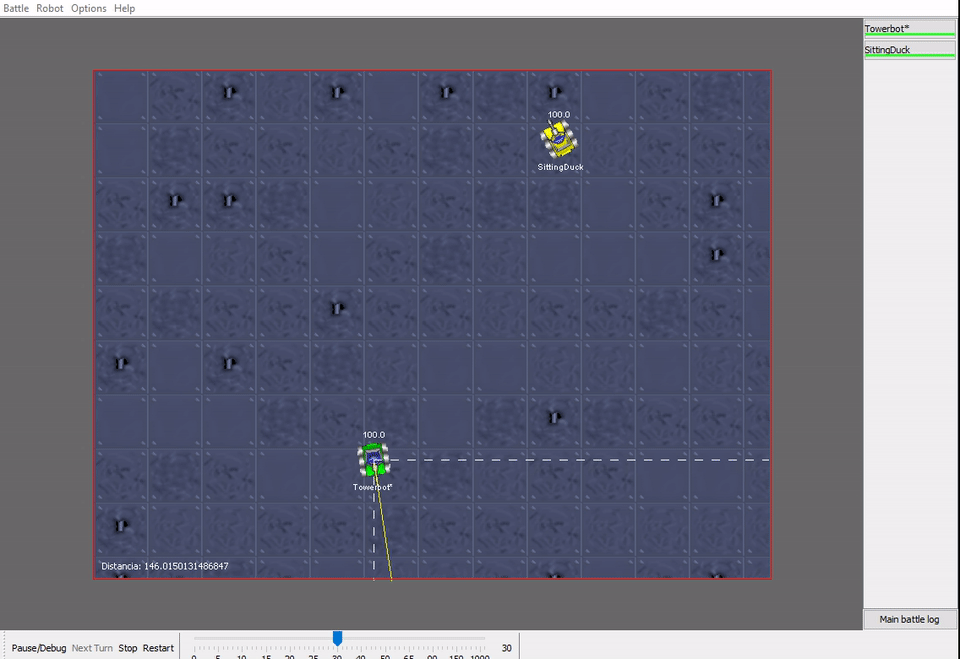Well, if your need is just to calculate the distance to the walls, here is an example code that does this:
package towerbot;
import robocode.*;
import java.awt.*;
import java.awt.geom.*;
public class Towerbot extends robocode.Robot
{
boolean movingforward;
Point2D direcao; // Vetor normalizado com a direção de movimento do tanque
Point2D canto; // Vetor do tanque até o canto mais próximo a que ele se aproxima
double distancia; // Distância até as paredes
final double limite = 80; // Limite utilizado para troca de direção
public void run() {
setBodyColor(new Color(0,200,0));
while(true) {
ahead(5);
calculaDistancia();
if(distancia <= limite)
turnLeft(180);
}
}
public void calculaDistancia() {
// Pega a altura e largura do campo de batalha e posição x,y do tanque
double h = getBattleFieldHeight(); // Altura
double w = getBattleFieldWidth(); // Largura
double x = getX();
double y = getY();
// Pega a direção em que o tank se move e a sua posição atual (x, y) no campo de batalha
double ang = getHeading(); // O ângulo está em graus, variando entre 0 (apontando pra cima) e 359) no sentido horário
// Calcula os vetor normal de direção do tanque
double dx = Math.sin(Math.toRadians(ang));
double dy = Math.cos(Math.toRadians(ang));
direcao = new Point2D.Double(dx, dy);
// Calcula o vetor do tanque em direção ao canto mais próximo da direção e sentido que ele segue
dx = (direcao.getX() > 0) ? w - x : -x;
dy = (direcao.getY() > 0) ? h - y : -y;
canto = new Point2D.Double(dx, dy);
// Calcula os angulos entre o vetor de direcao e os vetores dos os eixos x e y
double angX = Math.acos(Math.abs(direcao.getX()));
double angY = Math.acos(Math.abs(direcao.getY()));
// A distância é o cateto adjascente do menor ângulo
if(angY < angX)
distancia = Math.abs(canto.getY() / Math.cos(angY));
else
distancia = Math.abs(canto.getX() / Math.cos(angX));
}
public void onPaint(Graphics2D g) {
// Desenha a linha até a parede em amarelo se maior do que o limite, e em vermelho se menor do que o limite
if(distancia <= limite)
g.setColor(java.awt.Color.RED);
else
g.setColor(java.awt.Color.YELLOW);
g.drawLine((int) getX(), (int) getY(), (int) (getX() + (distancia * direcao.getX())), (int) (getY() + (distancia * direcao.getY())));
// Desenha o valor da distância em branco
g.setColor(java.awt.Color.WHITE);
g.drawString("Distancia: " + distancia, 10, 10);
// Desenha as componentes do vetor do canto tracejados em branco
Stroke pontilhado = new BasicStroke(1, BasicStroke.CAP_BUTT, BasicStroke.JOIN_BEVEL, 0, new float[]{10}, 0);
g.setStroke(pontilhado);
g.setColor(java.awt.Color.WHITE);
g.drawLine((int) getX(), (int) getY(), (int) (getX() + canto.getX()), (int) getY()); // Componente em X
g.drawLine((int) getX(), (int) getY(), (int) getX(), (int) (getY() + canto.getY())); // Componente em Y
}
public void onScannedRobot(ScannedRobotEvent e) {
//turnGunRight(getHeading() - getGunHeading() + e.getBearing());
//fire(1);
}
public void onHitByBullet(HitByBulletEvent e) {
}
public void onHitWall(HitWallEvent e) {
}
}
The result is a robot with this behavior:

Explainingthecode:
Basically,Iusesomegeometriccalculations(Itriedtodomoredidactically)togetthedirectionvectorofthetank'smotion(fromtheanglethattheRobocodereturns)andthencalculatethecomponentsonthexandyaxes(markedwithdottedlines)and"design" the direction vector according to the smallest angle side (basically, the distance is the hypotenuse thrown in the cosine formula).
The "decision mechanism" is very simple, and as you wanted: it reverses the direction of movement if the distance becomes smaller than an established limit.
Notes :
- Note that tracings are debugging information drawn in the
onPaint method call and need to be enabled with the button
" Paint " in your robot's console window.
- There are other better ways to make the robot avoid walls. I suggest reading the documentation, especially examples such as
Wall Smoothing (and Your implementations ).






